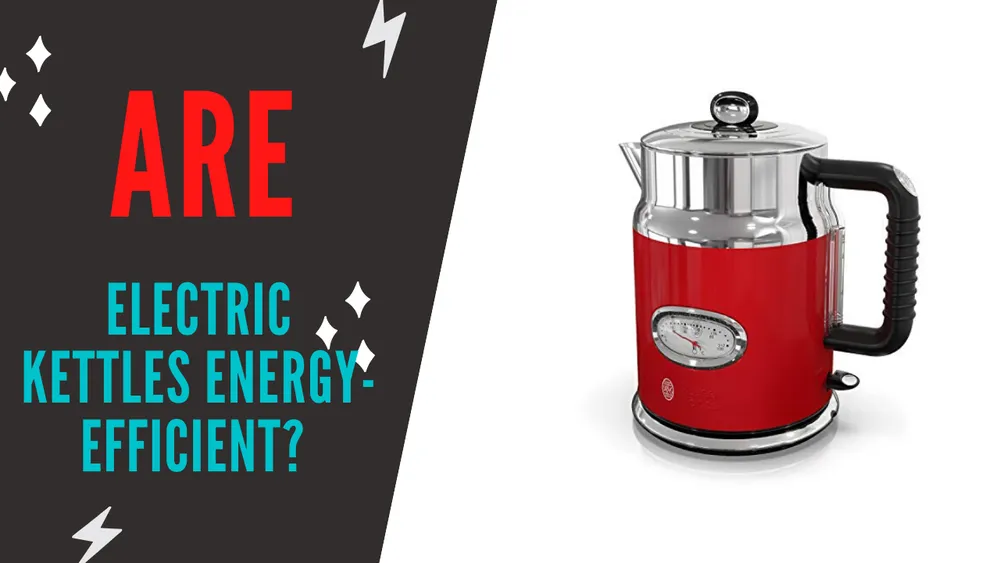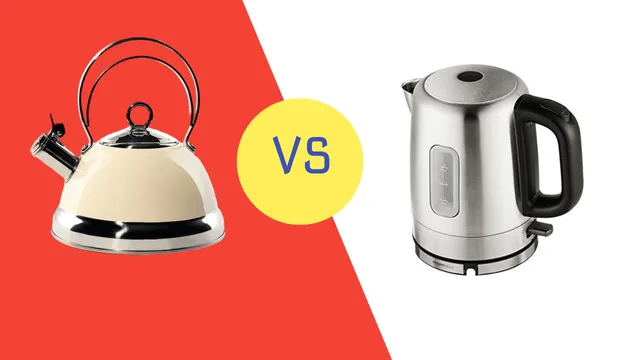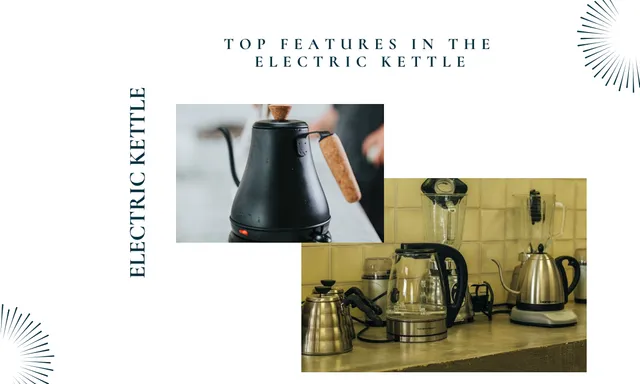Are Electric Kettles Energy-Efficient? A Comprehensive Analysis
-
 Dragos
Dragos - January 19, 2024

Electric kettles have become an indispensable appliance in many households, offering convenience and versatility in preparing hot beverages and quick meals. As energy consumption and environmental impact become increasingly important considerations for consumers, it’s crucial to examine the energy efficiency of these everyday appliances. This article delves into the energy efficiency of electric kettles, comparing them with other heating methods to help you make an informed decision about their use in your home.
How Electric Kettles Work
Understanding the mechanics of electric kettles is crucial to appreciating their energy efficiency. The basic principle behind electric kettles is relatively simple, but the engineering that goes into making them efficient is quite sophisticated.
-
Heating Element: At the heart of an electric kettle is a metallic coil or plate at the bottom, made of a high-resistance material such as nichrome. This element is responsible for converting electrical energy into heat.
-
Electrical Current: When the kettle is connected to a power source and switched on, an electrical current flows through the heating element.
-
Heat Generation: The heat generated by the element is based on Joule’s First Law, expressed by the formula H = I²R, where:
- H: Heat generated
- I: Electrical current flowing through the element
- R: Resistance of the material
This law explains why materials with higher resistance, like nichrome, are used for heating elements – they generate more heat for a given current.
-
Temperature Control: A bi-metallic strip acts as a temperature sensor. As the water temperature rises, this strip bends due to the different expansion rates of the two metals it’s made from. At a preset temperature (typically 100°C or 212°F for boiling), the strip triggers a switch that cuts off the power supply.
-
Insulation: Most modern kettles are well-insulated to minimize heat loss during the boiling process and to keep the exterior cool to the touch.
-
Safety Features: Many kettles include additional safety features such as boil-dry protection, which shuts off the kettle if there’s insufficient water, preventing damage to the heating element.
This efficient design allows electric kettles to heat water quickly and with minimal energy waste, contributing to their overall energy efficiency. The direct contact between the heating element and water, combined with the enclosed design, means that most of the energy used goes directly into heating the water, rather than being lost to the surrounding environment.
Learn more about how electric kettles have made our lives easier
Energy Consumption of Electric Kettles
To assess the energy efficiency of electric kettles, it’s important to break down their power usage and understand how it translates into real-world energy consumption. Let’s examine the typical energy use of an electric kettle:
| Aspect | Details |
|---|---|
| Average Power Rating | 1200 watts |
| Energy Consumption | 1200 joules per second |
| Typical Boiling Time | 2 minutes |
| Energy for Boiling | 144 kilojoules |
| Electricity Unit | 1 kilowatt-hour (kWh) = 1 unit |
| Daily Usage (1 hour) | 1 unit of electricity |
To put these numbers into perspective:
- A 1200-watt kettle operating for 2 minutes uses about 0.04 kWh of electricity.
- If you use your kettle 5 times a day, that’s approximately 0.2 kWh per day or 73 kWh per year.
- At an average electricity rate of $0.13 per kWh (US average), this amounts to about $9.50 per year for daily kettle use.
It’s worth noting that these figures can vary based on factors such as:
- The specific model of the kettle and its power rating
- The amount of water being boiled each time
- The starting temperature of the water
- The desired final temperature (boiling vs. lower temperatures for specific beverages)
While the power consumption of electric kettles might seem high at first glance, their efficiency lies in their ability to heat water quickly and directly. This rapid heating means they’re drawing power for a shorter period compared to other methods of heating water.
For those interested in maximizing efficiency, some modern kettles come with features like:
- Variable temperature settings for different types of beverages
- Keep-warm functions that maintain water temperature without constant reheating
- Precise minimum fill lines to prevent heating more water than necessary
Understanding these energy consumption details can help users make more informed decisions about their kettle usage and its impact on their overall energy consumption.
For more on efficient kettle usage, check our guide on how to cook with just a kettle.
Comparing Energy Efficiency
To truly understand the energy efficiency of electric kettles, it’s essential to compare them with other common methods of heating water. Let’s look at how electric kettles stack up against gas stoves and induction stoves in terms of energy efficiency.
Electric Kettle vs. Gas Stove
| Aspect | Electric Kettle | Gas Stove |
|---|---|---|
| Direct Heating | Yes (water only) | No (heats kettle first) |
| Heat Wastage | Lower | Higher |
| Overall Efficiency | High in direct use | Higher when considering energy production |
| Portability | Highly portable | Not portable |
| Cost Efficiency | Depends on local electricity rates | Depends on local gas prices |
Electric kettles typically have an efficiency rate of about 80-90%, meaning 80-90% of the energy used goes directly into heating the water. Gas stoves, on the other hand, have an efficiency rate of about 40-50% when used to heat water, as much of the heat is lost to the surrounding air.
However, it’s important to consider the entire energy chain. While electric kettles are more efficient at the point of use, the overall efficiency can be affected by how the electricity is generated. In areas where electricity is primarily produced from fossil fuels, the total energy efficiency might be lower than using a gas stove directly.
Electric Kettle vs. Induction Stove
| Aspect | Electric Kettle | Induction Stove |
|---|---|---|
| Direct Heating | Yes (water only) | No (heats pot first) |
| Energy Source | Electricity | Electricity |
| Efficiency | Higher | Lower |
| Versatility | Limited to boiling | Multiple cooking functions |
Induction stoves are generally more efficient than traditional electric or gas stoves, with an efficiency rate of about 85-90%. However, when it comes to heating water, electric kettles still have an edge. This is because:
- Electric kettles heat the water directly, while induction stoves heat the pot, which then heats the water.
- Electric kettles are enclosed, reducing heat loss to the environment.
- The automatic shut-off feature in electric kettles prevents energy waste from overheating.
It’s worth noting that the efficiency of both electric kettles and induction stoves can vary based on the quality and design of the appliance. High-end models of both types often incorporate energy-saving features that can improve their efficiency.
When considering which method to use, think about your specific needs:
- For quick, efficient boiling of water for tea, coffee, or instant meals, an electric kettle is typically the most energy-efficient choice.
- For cooking that requires precise temperature control or multiple functions, an induction stove might be more suitable, despite being slightly less efficient for water boiling.
For a detailed comparison of kettle types, see our article on stovetop kettle vs. electric kettle.
Factors Affecting Electric Kettle Efficiency
While electric kettles are generally efficient appliances, several factors can influence their energy efficiency. Understanding these factors can help you maximize the efficiency of your kettle and reduce energy consumption:
-
Kettle Capacity: One of the most significant factors affecting efficiency is the amount of water being heated. Boiling only the needed amount of water saves energy. Many kettles have minimum and maximum fill lines – adhering to these can help optimize energy use.
-
Maintenance: Regular maintenance, particularly descaling, is crucial for maintaining efficiency. Limescale buildup on the heating element acts as an insulator, reducing heat transfer efficiency and increasing energy consumption.
-
Insulation: Well-insulated kettles retain heat better, reducing the energy needed to maintain water temperature. Look for kettles with double-wall construction or those made from materials with good insulating properties.
-
Power Rating: Higher wattage kettles boil water faster but consume more power. While they might use more energy in the short term, they can be more efficient overall by reducing the time the kettle is in use.
-
Heating Element Design: The design and quality of the heating element can affect efficiency. Elements that provide more direct and even heating tend to be more efficient.
-
Automatic Shut-off Accuracy: The precision of the automatic shut-off mechanism affects efficiency. A more accurate mechanism prevents unnecessary boiling and energy waste.
-
Water Quality: Hard water can lead to faster limescale buildup, reducing efficiency over time. Using filtered water can help maintain kettle efficiency.
-
Starting Water Temperature: The initial temperature of the water affects energy consumption. Using room temperature water instead of cold water from the tap can slightly reduce energy use.
-
Frequency of Use: Reheating water that has cooled down consumes more energy than boiling fresh water. If you frequently need hot water, consider a kettle with a keep-warm function.
-
Lid Design: A well-sealed lid helps retain heat and steam, improving efficiency during the boiling process.
By considering these factors when choosing and using an electric kettle, you can ensure that you’re getting the most energy-efficient performance possible. Regular maintenance, proper usage habits, and selecting a kettle with features that match your needs can all contribute to improved energy efficiency.
Discover the best variable temperature kettles for precise and efficient brewing
Environmental Impact
While electric kettles are efficient in direct use, it’s important to consider their broader environmental impact. The overall ecological footprint of an electric kettle extends beyond its energy consumption during use:
-
Electricity Source: The environmental impact of using an electric kettle varies significantly based on how your electricity is generated. In areas where electricity is primarily produced from renewable sources like solar, wind, or hydroelectric power, the environmental impact is much lower compared to regions relying heavily on fossil fuels.
-
Manufacturing: The production of electric kettles has its own environmental cost. This includes:
- Resource extraction for materials like plastic, metal, and electronic components
- Energy used in the manufacturing process
- Packaging materials and transportation
-
Lifespan: Longer-lasting kettles reduce waste and resource consumption. The durability of a kettle affects its overall environmental impact – a kettle that lasts for many years is generally more eco-friendly than one that needs frequent replacement.
-
Energy Efficiency Over Time: As kettles age, they may become less efficient, especially if not properly maintained. This can lead to increased energy consumption over time.
-
End-of-Life Considerations: The recyclability and disposal methods for electric kettles are important environmental factors. Many kettles contain materials that can be recycled, but improper disposal can lead to electronic waste issues.
To minimize the environmental impact of using an electric kettle:
- Choose energy-efficient models with good durability ratings.
- Maintain your kettle properly to ensure long-term efficiency.
- Use your kettle efficiently by only boiling the amount of water needed.
- Consider the energy source in your area and how it affects the overall environmental impact of electric appliances.
- Look for kettles made with recyclable materials or from manufacturers with strong environmental policies.
- Proper disposal or recycling of old kettles is crucial to reduce electronic waste.
It’s also worth noting that despite these considerations, electric kettles are generally more environmentally friendly for boiling water compared to stovetops or microwaves, especially when used efficiently.
For eco-friendly options, explore our guide on the best smart kettles with energy-saving features.
Tips for Maximizing Electric Kettle Efficiency
To get the most out of your electric kettle while minimizing energy consumption, consider the following tips:
-
Boil Only the Amount of Water Needed: This is the single most effective way to reduce energy usage. Use the kettle’s measurement markings or a separate measuring cup to add just the right amount of water.
-
Descale Regularly: Limescale buildup can significantly reduce heating efficiency. Descale your kettle every few months or more frequently in hard water areas. You can use commercial descaling products or natural solutions like vinegar.
-
Choose a Kettle with Appropriate Capacity: Select a kettle size that matches your typical usage. A smaller kettle is more efficient for individuals or small households, while larger families might benefit from a bigger model to avoid multiple boiling cycles.
-
Use the Keep-Warm Function Judiciously: If your kettle has a keep-warm function, use it only when you know you’ll need hot water again soon. For longer periods, it’s more efficient to reboil fresh water.
-
Consider a Variable Temperature Kettle: For beverages that don’t require boiling water (like certain teas or coffee), a variable temperature kettle can save energy by heating water only to the necessary temperature.
-
Avoid Repeated Reheating: Try to use water soon after boiling. Repeatedly reheating water wastes energy.
-
Start with Hot Water from the Tap: If you have a well-insulated hot water system, starting with hot tap water can reduce the energy needed to reach boiling point. However, for drinking purposes, it’s generally recommended to use cold water for better taste and to avoid any potential contamination from hot water systems.
-
Keep the Lid Closed: Ensure the lid is properly closed when boiling to prevent heat escape and reduce boiling time.
-
Maintain Your Kettle: Regular cleaning and maintenance not only prolong the life of your kettle but also maintain its efficiency.
-
Insulate External Surface: If your kettle gets hot on the outside, consider using an external insulating cover to reduce heat loss.
-
Time Your Usage: If you have off-peak electricity rates, consider using your kettle during these times for cost savings.
-
Invest in Quality: A high-quality kettle may be more expensive initially but can offer better efficiency and longevity, saving energy and money in the long run.
By implementing these tips, you can significantly reduce the energy consumption of your electric kettle while still enjoying the convenience it offers. Remember, small changes in daily habits can lead to substantial energy savings over time.
Future Trends in Electric Kettle Energy Efficiency
As technology advances and environmental concerns grow, the future of electric kettles is likely to see significant improvements in energy efficiency. Here are some trends and innovations we can expect to see:
-
Smart Kettle Technology:
- Integration with smart home systems for optimized energy use
- AI-powered usage prediction to preheat water at the right times
- Real-time energy consumption tracking via smartphone apps
-
Advanced Materials:
- Development of new materials with superior heat retention properties
- Use of eco-friendly, recyclable materials in kettle construction
-
Improved Heating Elements:
- More efficient heating elements that require less energy
- Faster heating technologies to reduce overall energy consumption
-
Precision Temperature Control:
- Enhanced sensors for more accurate temperature control
- Ability to set exact temperatures for different types of beverages
-
Energy Harvesting:
- Kettles that can capture and reuse waste heat
- Integration of small-scale renewable energy sources (e.g., solar panels on the kettle base)
-
Water Quality Optimization:
- Built-in water filtration systems to reduce scale buildup and maintain efficiency
- Sensors to detect water hardness and adjust heating patterns accordingly
-
Eco-Mode Features:
- Enhanced standby modes with minimal energy consumption
- Automatic eco-settings based on usage patterns
-
Modular Design:
- Easily replaceable parts to extend kettle lifespan and reduce waste
- Upgradable components to keep up with efficiency improvements
-
Energy Source Flexibility:
- Kettles that can switch between different power sources (e.g., electric and induction) for optimal efficiency
-
User Behavior Modification:
- Features that educate and encourage users to adopt more energy-efficient habits
- Gamification elements to promote energy-saving practices
As these innovations emerge, consumers can look forward to electric kettles that not only provide convenience but also align with growing environmental consciousness and energy-saving goals.
FAQs About Electric Kettle Energy Efficiency
-
Q: Do electric kettles use a lot of electricity? A: While they have high wattage, their quick heating makes them efficient for short-term use. On average, an electric kettle uses about 0.04 kWh per use, which is relatively low compared to many other kitchen appliances.
-
Q: Is it cheaper to boil water in a kettle or on the stove? A: Generally, electric kettles are more cost-effective due to their higher efficiency and faster boiling times. However, the exact comparison depends on local utility prices for electricity and gas. In most cases, the electric kettle comes out ahead, especially for small amounts of water.
-
Q: How can I reduce my electric kettle’s energy consumption? A: Key strategies include boiling only necessary amounts of water, maintaining the kettle well (regular descaling), avoiding frequent reheating, and using a kettle with good insulation. Also, consider using any energy-saving features your kettle might have, like variable temperature settings.
-
Q: Are smart kettles more energy-efficient? A: Many smart kettles offer energy-saving features like precise temperature control, scheduling, and usage tracking. These features can lead to more efficient use, but the base efficiency depends on the kettle’s design and heating element. A well-used standard kettle can be just as efficient as a poorly used smart kettle.
-
Q: How does the energy efficiency of electric kettles compare to microwave ovens for boiling water? A: Electric kettles are generally more efficient than microwaves for boiling water. Kettles heat water directly and are better insulated, while microwaves heat less evenly and can lose more energy to the surrounding air.
-
Q: Does the material of the kettle affect its energy efficiency? A: Yes, the material can impact efficiency. Stainless steel and glass kettles often retain heat better than plastic ones. However, the design and quality of the heating element play a more significant role in overall efficiency.
-
Q: How much can I save on my energy bill by using an electric kettle efficiently? A: The savings can vary, but efficient use of an electric kettle (like boiling only needed amounts) can save around 10-20% on the energy used for boiling water. For a household that frequently boils water, this could translate to savings of $5-$10 per year on electricity bills.
-
Q: Are there any government standards or certifications for electric kettle efficiency? A: While there aren’t specific standards for kettles in many countries, look for general energy efficiency certifications like Energy Star in the US or the EU Energy Label in Europe. These can indicate overall energy efficiency of appliances.
Conclusion
Electric kettles prove to be energy-efficient appliances for quick water heating tasks. Their direct heating method and automatic shut-off features contribute significantly to their efficiency. The rapid heating process, combined with good insulation in modern models, means that a large portion of the energy used goes directly into heating the water, with minimal waste.
However, the overall energy impact depends on various factors:
- Usage patterns (frequency of use and amount of water boiled)
- Maintenance habits (regular descaling and cleaning)
- Local energy prices (electricity costs vary by region)
- The source of electricity (renewable vs. non-renewable)
When choosing between an electric kettle and other heating methods, consider your specific needs, usage frequency, and local energy costs. For most households, an electric kettle offers a good balance of convenience and energy efficiency, especially for frequent, small-volume boiling tasks.
Key takeaways for maximizing the efficiency of your electric kettle:
- Only boil the amount of water you need
- Maintain your kettle regularly, especially descaling
- Choose a kettle with features that match your usage patterns
- Consider the environmental impact of your electricity source
By understanding the energy efficiency of electric kettles and using them wisely, you can enjoy the convenience they offer while minimizing your energy consumption and environmental impact. As technology advances, we can expect even more efficient and environmentally friendly electric kettles in the future, further enhancing their role in energy-conscious households.
For more insights on choosing and using electric kettles, explore our other articles:
- What to Check When Buying an Electric Kettle
- Best Electric Kettles with Gooseneck
- How Electric Kettles Made Our Life Easier
By making informed choices and adopting efficient usage habits, you can make your electric kettle an eco-friendly and cost-effective addition to your kitchen.






